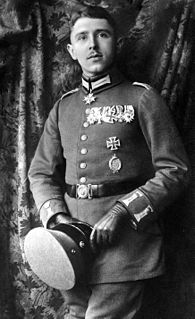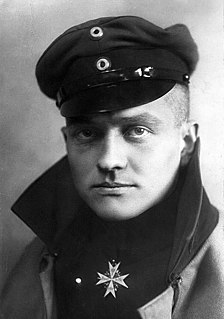
The Fokker Scourge occurred during the First World War from July 1915 to early 1916. Imperial German Flying Corps units, equipped with Fokker Eindecker fighters, gained an advantage over the Royal Flying Corps (RFC) and the French Aéronautique Militaire.

Max ImmelmannPLM was the first German World War I flying ace. He was a pioneer in fighter aviation and is often mistakenly credited with the first aerial victory using a synchronized gun, which was in fact achieved on 1 July 1915 by the German ace Kurt Wintgens. He was the first aviator to receive the Pour le Mérite, being awarded it at the same time as Oswald Boelcke. His name has become attached to a common flying tactic, the Immelmann turn, and remains a byword in aviation. He is credited with 15 aerial victories.

The Deutsche Luftstreitkräfte —known before October 1916 as Fliegertruppen —was the air arm of the Imperial German Army. In English-language sources it is usually referred to as the Imperial German Air Service, although that is not a literal translation of either name. German naval aviators of the Marine-Fliegerabteilung were an integral part of the Imperial German Navy. Both military branches operated aeroplanes, observation balloons and airships.

Hans-Joachim Buddecke was a German flying ace in World War I, credited with thirteen victories. He was the third ace, after Max Immelmann and Oswald Boelcke, to earn the Blue Max. He saw combat in three theaters during the First World War: Bulgaria, Turkey, and the Western Front. His exploits at Gallipoli arena won him the nickname El-Schahin, "hunter falcon".

Otto Kissenberth was a German flying ace of World War I credited with 20 aerial victories. He was a prewar mechanical engineer who joined the German air service in 1914. After being trained and after serving as a reconnaissance pilot, he became one of the first German fighter pilots, flying with Kampfeinsitzerkommando KEK Einsisheim. He scored six victories with this unit as it morphed into a fighter squadron, Jagdstaffel 16. His success brought him command of Jagdstaffel 23 on 4 August 1917. He would run his victory tally to 20, downing his final victim using a captured British Sopwith Camel on 20 May 1918. Nine days later, a crash while flying the Camel ended Kissenberth's combat career. His injuries were severe enough he was not returned to combat, instead being assigned to command Schleissheim's flying school. Although Otto Kissenberth survived the war, he died soon after in a mountaineering accident on 2 August 1919.

The following are lists of World War I flying aces. Historically, a flying ace was defined as a military aviator credited with shooting down five or more enemy aircraft during aerial combat. The term was first used by French newspapers, describing Adolphe Pégoud as l'as, after he downed seven German aircraft.

LeutnantOtto Parschau was a German World War I flying ace and recipient of the Pour le Mérite, Royal House Order of Hohenzollern, and Iron Cross, First Class. He was noted as one of the pre-eminent aces on the Fokker Eindecker. He was one of the world's first flying aces. Parschau and Leutnant Kurt Wintgens were the pilots chosen to fly the prototype of the revolutionary Fokker Eindecker fighter plane with a machine gun synchronized to fire safely through its propeller arc via use of a gun synchronizer.

A Jagdstaffel was a fighter Staffel (squadron) of the German Imperial Luftstreitkräfte during World War I.

LeutnantKurt Wintgens was a German World War I fighter ace. He was the first military fighter pilot to score a victory over an opposing aircraft, while piloting an aircraft armed with a synchronized machine gun. Wintgens was the recipient of the Iron Cross and the Pour le Mérite.

Wilhelm Frankl, Pour le Mérite, Royal House Order of Hohenzollern, Iron Cross, was a World War I fighter ace credited with 20 aerial victories. He scored his first aerial victory with a carbine on 10 May 1915, before the Fokker Eindecker, the world's first dedicated fighter airplane, came into use. Once Frankl was equipped with an Eindecker, he became part of Germany's air superiority offensive, the Fokker Scourge, shooting down eight more enemy airplanes. He became one of the first eight aces in Germany's service, and one of its first winners of the prestigious Pour le Merite. As such, he was appointed to lead one of the world's first fighter squadrons, Jagdstaffel 4. Although he died fighting for Germany on 8 April 1917, in later years the Nazis would ignore his wartime conversion to Christianity, and expunge his heroic record because he was Jewish.

Doctor OberleutnantOtto Schmidt HOH, IC was a German World War I fighter ace credited with 20 aerial victories, including eight against enemy observation balloons. He commanded three different jagdstaffeln (squadrons) as well as a jagdgruppe.
Leutnant Ernst Hess HOH IC was a World War I flying ace credited with 17 confirmed and four unconfirmed aerial victories. Hess was one of a few World War I pilots involved in aviation prewar, as he gained his civil pilot's license on 26 September 1913. He was already enrolled in Die Fliegertruppen of the Imperial German Army when World War I began. He qualified for his military pilot's license on 21 November 1914, and was launched on his flying career as one of Germany's first fighter pilots. He would score his first aerial victory in tandem with Oswald Boelcke on 5 January 1916. He would rotate through four assignments before scoring a dozen victories within July–September 1917 while flying an Albatros D.Va for Jagdstaffel 28. On 19 September 1917, he was promoted to command of Jagdstaffel 19. He had just been appointed to command of a Jagdgruppe being formed by Germany's First Army when he was killed in combat on 23 December 1917.
Vizefeldwebel Josef Schwendemann was a World War I flying ace credited with 17 aerial victories.
Leutnant Ludwig Hanstein HOH, Bavaria's MMO was a World War I flying ace credited with 16 aerial victories.
Gustav Leffers was a German flying ace in World War I, credited with 9 victories.

Leutnant Walter Höhndorf (1892-1917) was a pioneer aviator, test pilot, airplane designer and constructor, and fighter ace during World War I. He was credited with twelve aerial victories while flying for the Imperial German Air Service. Only one of his victories was achieved with a fighter squadron; the rest were scored while he flew for artillery direction and reconnaissance units.
LeutnantHermann Pfeiffer IC was a German World War I flying ace credited with eleven aerial victories.
Leutnant Hans von Keudell was a World War I flying ace credited with twelve aerial victories.
Leutnant Walter Kypke HOH, IC was an early military aviator in the predecessor to the Luftwaffe, the Luftstreitkräfte. This itinerant flying ace accumulated nine official aerial victories, which were scored in four of the seven flying units with which he served; the wins were spread over a three-year period. Kypke served for the entirety of World War I, rising to command during his final year of combat.

During World War I, the national air services involved developed their own methods of assessing and assigning credit for aerial victories.













